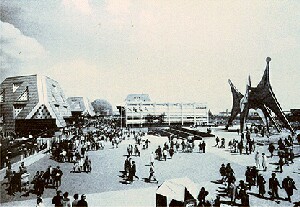|
1 |
 Copyright: Architectural Review, Bd. 142, Nr. 846, August 1976, S. 99 |
|
1 |
 Copyright: Architectural Review, Bd. 142, Nr. 846, August 1976, S. 99 |
The work on conceiving the theme of the exhibition began in May 1963 with a conference of leading intellectuals, university members, artists and authors in Quebec. This 'braintrust' looked for modern terms of reference for Expo '67 which would embrace the entire development of mankind. It was no longer scientific, technological and industrial progress alone which was to be presented and promoted in the exhibition, but also man's social responsibility and environmental consciousness. The commission found the fitting leitmotif in the title of the novel "Terre des Hommes": "Man and his World" (also known as "Wind, Sand and Stars). In his book, Saint-Exupéry defined what he saw as the main characteristic of man: "To be a man is to feel that through one's own contribution one helps to build the world."
The motto was arranged neatly for the theme exhibitions in nine pavilions with seventeen spheres of content, which were to present the activities of man in all his areas of activity and possibilities. They placed man in his role as a creator, explorer, producer and manufacturer, as a social being, showed the conditions of human life and examined his health and protection of his environment. Humanitarian objectives and principles gained in importance in the sixties in view of the scientific and technological and political and economic competition between nations and power blocs, and so international understanding was defined as the aim of the exhibition. The event thus stood in the tradition of the Brussels world exhibition, yet once again it mainly presented technology-oriented and dirigiste solutions to the problems of humanity.
An attempt was naturally made to interpret the theme allegorically in the logo for Expo '67. Julien Hébert, a graphics designer from Montreal, used for it an ancient, catchy symbol for people, which he arranged in pairs in a circle. This easy-to-understand symbol for the meeting of humanity was very popular. The symbol of the world exhibition was to be the sculpture 'The Man' by Alexander Calder, which was over twenty meters high and 60 tons in weight and which the artist had designed in stainless steel for the Canadian nickel extraction company. In simple, strongly abstract disk forms, it represented a group of people that was held together by parabolic plates and supports.
The pavilions for the theme exhibitions mostly followed the general trend of Expo '67 of covering large trussless interior spaces with lightweight space frames. In the pavilion 'Man and Community' of the architects Erikson & Massey, the roof was formed by hexagonal garlands of beams which were stacked on top of each other and tapered upwards like a parabola. Since the garlands of beams were arranged so as to be offset, there were gaps that were covered by floor grids and corrugated, semi-transparent plastic segments. The view into the deep funnels right up to the top of the roof made many a visitor feel dizzy. This daring design actually only covered a restroom that was furnished with water areas, a few benches and plants; the actual exhibition halls were constructed behind it on a hexagonal ground plan and were likewise covered by a beamed ceiling structure.
| Year: 1967 | City: Montreal | Country: Canada |
| Duration: 28th April - 27th October 1967 | ||